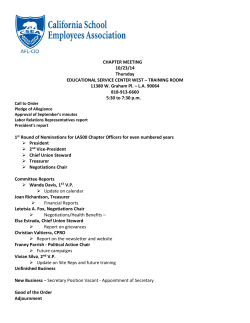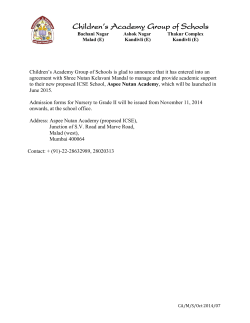
Nanoday_prog_updated_24.11.14 104.20 Kb
The European Workshop on Novel Aspects of Nanomedicine Nanomedicine Now - The Challenge to Translate Scientific Results to Applications for Patients Thursday, November 27, 2014 Room 5 - Council of Europe, Strasbourg Programme 08.30 Welcome Addresses Paul Rübig, MEP 1 / ITRE 2 Committee / STOA3 Chair / Past President ITRE Committee (introduction by Felix Unger, President European Academy of Sciences and Arts) Antonio Correia De Campos, MEP / Former STOA Chair / Former Minister of Health Portugal (introduction by Rodrigo Martins, President of E-MRS Senate) Catherine Florentz, University of Strasbourg Vice-President, in charge of Research (introduction by Eric Fogarassy, Head of Télécom Physique Strasbourg) 1. Opening 09.00 Welcome Address by UNESCO Paul Siffert, UNESCO Chair in Materials Science and Engineering / University of Strasbourg and Secretary General of E-MRS, Strasbourg 09.05 Welcome Address by the French Academy of Medicine Edwin Milgrom, French Academy of Medicine 09.10 Welcome Address by the European Academy of Sciences and Arts Felix Unger, President European Academy of Sciences and Arts 09.15 Welcome Address by the European Science Foundation Jean-Claude Worms, Head of Science Support Office 09:20 Welcome Address by INTERREG Upper Rhine project Nano@Matrix Genevieve Pourroy, Scientific Coordinator of the INTERREG Project Nano@Matrix, Research Director, CNRS IPCMS – Department of Chemistry and Inorganic Materials, Strasbourg 09.25 Welcome Address by the European Foundation for Clinical Nanomedicine Beat Löffler, CEO of the European Foundation for Clinical Nanomedicine (CLINAM), Basel 1 MEP: Member of the European Parliament ITRE : Committee on Industry, Research and Energy 3 STOA: Science and Technology Options Assessment 2 This event is co-financed by the European Regional Development Fund – ERDF in the framework of the INTERREG IV Upper Rhine Program. 2. Pathway of Nanomedicine - Experiences and Outlook Chair Yechezkel Barenholz, Hebrew University, Hadassah Medical School, Jerusalem 09.30 The Experience with Doxil to Translate Results to Clinical Application Yechezkel Barenholz, Hebrew University, Hadassah Medical School, Jerusalem 09.45 Innovative Applications of Nanomedicine in Oncology – How far to Bedside? Christoph Alexiou, University of Erlangen, Erlangen 10.00 Nanomaterials for Medicine: The Key to Clinical and Pharmacological Use Andrew Owen, University of Liverpool, Liverpool 10.15 Nanomedicine at Clinic: What is Possible and what shall be Possible in 5 years Patrick Hunziker, Intensive Care Unit, University Hospital Basel and President of the European Society for Clinical Nanomedicine 10.30 Questions and Debate 10.45 Coffee Break 3. Conquering the Hurdles of Toxicity Chair Edwin Milgrom, French Academy of Medicine 11.10 Clinical Aspects of Immunotoxicity in Nanomedicines Jacques Descotes, Head, Poison Center and Pharmacovigilance Department Lyon University Hospitals, Lyon 11.25 Infusion Reactions to Nanomedicines: Causes, Prediction and Prevention of an Immune-Mediated Stress Reaction in Blood Janos Szebeni, Nanomedicine Research and Education Center, Semmelweis University & SeroScience Ltd, Budapest 11.40 Pitfalls and Development of Testing Strategies in Nanotoxicology Carsten Weiss, Group Leader, Molecular Toxicology of Genotoxins and Nanomaterials, Institute of Toxicology and Genetics, Karlsruhe Institute of Technology (KIT), Leopoldshafen 11.55 The Acceptability of Nanomaterials for Nanodrug Delivery Systems Peter van Hoogevest, Head Development and Scientific Department Lipoid GmbH, Ludwigshafen 12.10 Questions and Debate 12.30 Lunch 4. Imaging in Nanomedicine Chair Miroslav Mikolasik, MEP 13.30 Nanosized Probes for Medical Imaging: Challenges and Opportunities Alessandro Maiocchi, Research Projects Manager, Centro Ricerche Bracco, Bracco Imaging SpA, Colleretto Giacosa, TO 13.45 Dendrimer-nanoparticle conjugates as nanomedicine tools Delphine Felder-Flesch, Research Associate CNRS - IPCMS – Department of Organic Materials, Strasbourg 14.00 Advanced Image Analysis Creating Knowledge in an Automated Fashion (“Tissue Phenomics”) Gerd Binnig, Founder of Definiens Inc., Nobel Laureate, Munich 14.15 Questions and Debate This event is co-financed by the European Regional Development Fund – ERDF in the framework of the INTERREG IV Upper Rhine Program. 5. Nanomedicine: The Pharmaceutical Outlook and the Translational Technology Position Chair Beat Löffler, CEO of the CLINAM-Foundation, Basel 14.35 Now Nanomedicine develops from the View of a Pharma Company Bernd Riebesehl, Principal Fellow, Novartis Pharma AG, Basel 14.50 Practical CLINATEC Examples supporting a new methodology for a safer and accelerated translation of micro-nanotechnology at the bedside François Berger, CLINATEC Director, Grenoble 15.05 The nanomaterial-biomolecule corona: A critical factor in nanomedicine? Roland Stauber, Molecular and Cellular Oncology/Mainz Screening Center (MSC), Medical University Mainz 15.10 Questions and Debate 15.20 Coffee Break 6. The European Funding, the Regulatory and the Characterisation View for Nanomedicine Chair Patrick Hunziker, Intensive Care Unit, University Hospital Basel and President of the European Society for Clinical Nanomedicine 15.40 Horizon 2020 – The Future of Nanomedicine seen by EC Clara de la Torre, Director RTD.D, DG Research and Innovation, EC, Brussels 15.55 Enabling the Development of Nanomedicine in Europe Patrick Boisseau, CEA-Léti, Chairman of the Board of the European Technology Platform on Nanomedicine, ETPN, Grenoble 16.10 Regulatory Challenges to be tackled to bring Nanomedicine to Clinic Marisa Papaluca, European Medicines Agency, Human Medicines Evaluation Division, London 16.25 Characterisation Networking – The worldwide US Paradigm Scott E. McNeil, Director, Nanotechnology Characterization Laboratory, National Cancer Institute, Frederick, USA 16.40 Questions and Debate 7. Conclusions Chairs Patrick Hunziker, Intensive Care Unit, University Hospital Basel and President of the European Society for Clinical Nanomedicine Beat Löffler, CEO of the CLINAM-Foundation, Basel 17.00 Panel Discussion “Needs in Nanomedicine and its Development in Europe and Worldwide” Scott E. McNeil, Director, Nanotechnology Characterization Laboratory, National Cancer Institute, Frederick, USA Edwin Milgrom, French Academy of Medicine Marisa Papaluca, European Medicines Agency, Human Medicines Evaluation Division, London Herbert Von Bose, Former Director of the DG for Research and Innovation, EC, Brussels 17:30 Open Discussion 17.45 Closing Addresses Fabienne Keller, French Senator Antonio Correia De Campos, MEP / Former STOA Chair / Former Minister of Health Portugal 18.00 End This event is co-financed by the European Regional Development Fund – ERDF in the framework of the INTERREG IV Upper Rhine Program. Organizers UNESCO Chair in Materials Science and Engineering / University of Strasbourg French Academy of Medicine INTERREG Upper Rhine (Nano-Matrix project) European Commission (Directorate for Research and Innovation) European Academy of Sciences and Arts European Foundation for Clinical Nanomedicine (CLINAM) European Science Foundation (ESF) European Materials Research Society (E-MRS) Scientific Committee Yechezkel Barenholz, Hebrew University, Hadassah Medical School, Jerusalem Jacques Chambron, Faculty of Medicine, University of Strasbourg, corresponding member of the French Academy of Medicine Gabriel Crean, Vice-President for Technology and Director for Europe, CEA Tech, CEA, France Patrick Hunziker, CSO of the CLINAM-Foundation and University Hospital Basel Paul Siffert, UNESCO Chair in Materials Science and Engineering / University of Strasbourg and Secretary General of EMRS, Strasbourg Marcel Van de Voorde, Professor University of Technology Delft Organization Office E-MRS European Materials Research Society 23 Rue du Loess BP 20 F - 67037 Strasbourg Cedex 2 Tel +33-388-10 65 43 Fax +33-388-10 62 93 Email: emrs@emrs-strasbourg.com www.european-mrs.com This event is co-financed by the European Regional Development Fund – ERDF in the framework of the INTERREG IV Upper Rhine Program.
© Copyright 2024









